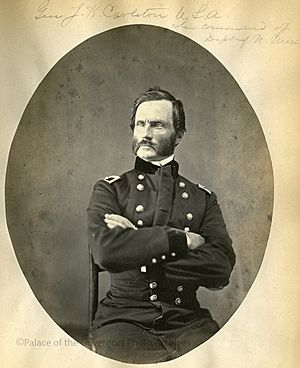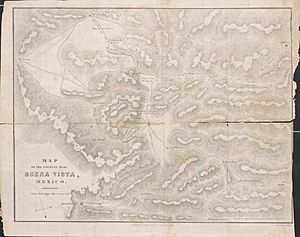James Henry Carleton facts for kids
Quick facts for kids
James Henry Carleton
|
|
|---|---|
 |
|
| Born | December 27, 1814 Lubec, Maine |
| Died | January 7, 1873 (aged 58) San Antonio, Texas |
| Place of burial |
Mount Auburn Cemetery, Cambridge, Massachusetts
|
| Allegiance |
|
| Service/ |
|
| Years of service | 1839–1873 |
| Rank |
|
| Unit | 1st U.S. Dragoons |
| Commands held |
|
| Battles/wars | |
| Other work | author |
James Henry Carleton (born December 27, 1814 – died January 7, 1873) was an important officer in the United States Army. He also served as a general for the Union Army during the American Civil War. Carleton is best known for his role in conflicts with Native American tribes in the Southwestern United States.
Contents
Life and Early Military Career
James Henry Carleton was born in Lubec, Maine. He joined the U.S. Army as a lieutenant in 1839. This was during the Aroostook War, a border dispute. He later took part in the Mexican–American War.
Carleton served with the 1st U.S. Dragoons. This unit was active in the Western United States. In 1844, he joined an expedition to the lands of the Pawnee and Oto tribes. One of his children, Henry Guy Carleton, became a journalist and playwright.
Investigating the Mountain Meadows Incident
In May 1859, Major Carleton and his troops were sent to Southern Utah Territory. Their mission was to escort a paymaster with government funds. They arrived at Mountain Meadows. Here, they met another group of soldiers.
These soldiers had orders to bury the victims of an event from September 1857. Carleton's dragoons helped bury the remains of 34 people in a large grave. They also built a simple monument with rocks and a cedar cross.
Carleton investigated what happened at Mountain Meadows. He believed that some settlers, disguised as Native Americans, along with Paiute tribesmen, had attacked and killed 120 travelers. These travelers were on their way to California. Carleton sent a special report about his findings.
In 1860, Carleton led another expedition called the Bitter Spring Expedition. His troops attacked suspected Paiute raiders. This happened along the Los Angeles – Salt Lake Road and Mojave Road.
Service During the Civil War
In 1861, Carleton helped form the 1st California Volunteer Infantry Regiment. He was appointed as its colonel. Later that year, he became the commander of the District of Southern California.
In 1862, Carleton led the California Column. This was a group of soldiers who marched across California, Arizona, New Mexico, and into Texas.
Advancing Through the Southwest
Carleton was promoted to brigadier general in April 1862. This happened during his march from California to Arizona. Along the way, his troops fought in the Battle of Picacho Pass. They also captured Tucson in Arizona.
The Californians then marched east. They faced the Apache people for the first time at the Battle of Apache Pass. After this battle, Carleton established Fort Bowie. This fort was built near Apache Pass to protect this important route.
The first soldiers of the California Column reached the Rio Grande River in New Mexico on July 4. They joined up with Union forces there. Carleton's troops were delayed by a large flood. They eventually crossed the river and pursued the Confederate army. They took control of southern New Mexico and most of West Texas.
Commanding in New Mexico
After the Confederate threat in New Mexico seemed to be over, Carleton took command of the Department of New Mexico. He was known for being a strict leader but was still liked by his soldiers. He kept spies along the New Mexico–Texas border. He also kept volunteer units from Colorado. These units had helped push the Confederates out of New Mexico.
In late 1862, Carleton put in place several security rules. These included special passes for travel, curfews, and military law.
Campaign Against the Mescalero Apache
As commander in New Mexico, Carleton focused on the threat from Apache and Navajo raiders. His first campaign was against the Mescalero Apache. This campaign was led by Kit Carson. Carson led New Mexican militia and California Volunteers.
In October 1862, Carleton established Fort Sumner. This fort was meant to hold captured Mescalero Apache people. However, some warned that the location was not suitable for many people.
In January 1863, an Apache leader named Mangas Coloradas agreed to meet with U.S. military leaders. He arrived at Fort McLane under a white flag of truce. He was taken into custody. Mangas Coloradas was later killed while reportedly trying to escape.
Carleton then focused on the Navajo people. He believed that strong actions were needed to stop Navajo raids. His main commander in this effort was Colonel Carson.
After the Navajo surrendered at Canyon de Chelly, the entire Navajo nation was forced to go on the Long Walk of the Navajo. This was a long, difficult journey to Fort Sumner. Carleton believed that this harsh approach was best for everyone. Many Navajos faced great hardship during this journey.
Carleton used Fort Sumner to house the Navajos, even though it was already holding many Mescalero Apaches. People had warned that the fort was not suitable for such a large number of people.
Conflict with Comanche and Kiowa
Carleton later sent Carson on another expedition. This was to stop raids by the Comanche and their Kiowa allies. This led to the Battle of Adobe Walls.
End of the Civil War Service
Near the end of the American Civil War in 1865, Carleton was given the honorary rank of major general in the regular army. He continued to command his volunteer troops until 1866. At that time, regular U.S. Army soldiers took over in the West.
Later Life and Writings
After leaving the Volunteer Army, Carleton was promoted to lieutenant colonel of the 4th U.S. Cavalry in July 1866.
Carleton wrote several books about military topics. These included The Battle of Buena Vista (1848) and Diary of an Excursion to the Ruins of Abo, Quarra, and the Grand Quivira in New Mexico in 1853 (1855). His book The Prairie Log Books was published after he died in 1944.
In 1856, Carleton was asked to study European cavalry tactics. He used observations from Captain George B. McClellan, who had recently returned from Europe.
Carleton died on January 7, 1873, at the age of 59. He passed away in San Antonio, Texas, while serving with the 4th Cavalry Regiment. He was buried in Mount Auburn Cemetery in Cambridge, Massachusetts. His son, Henry, was later buried next to him.
See also
- List of American Civil War generals (Union)
Sources
- Eicher, John H., & Eicher, David J., Civil War High Commands, Stanford University Press, 2001, ISBN: 0-8047-3641-3.
- Hunt, Aurora, James H. Carleton, 1814–1873, Western Frontier Dragoon, Frontier Military Series II, Glendale, California: The Arthur H. Clark Company, 1958.
- Pettis, George Henry, The California column. Its campaigns and services in New Mexico, Arizona and Texas, during the Civil War, with sketches of Brigadier General James H. Carleton, its commander, and other officers and soldiers, Santa Fe: New Mexican Printing Co., 1908 [1]
Research resources
- James Henry Carleton Papers : typescript transcripts of letters and reports, 1851-1865 (1 binder) are housed in the Department of Special Collections and University Archives at Stanford University Libraries


